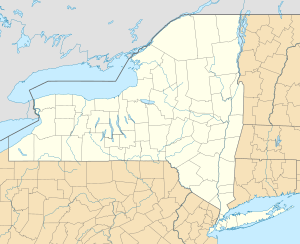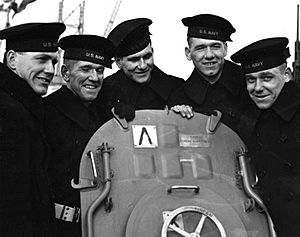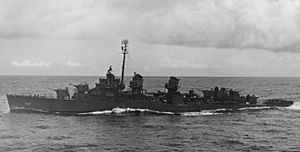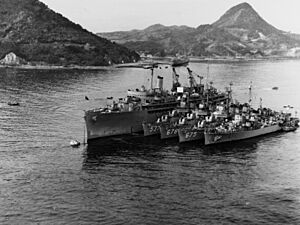USS The Sullivans (DD-537) facts for kids
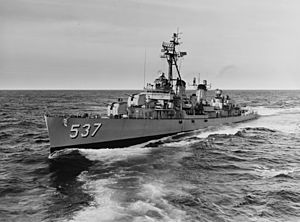
USS The Sullivans on 29 October 1962
|
|
Quick facts for kids History |
|
|---|---|
| Name | The Sullivans |
| Namesake | The Sullivan brothers |
| Builder | Bethlehem Shipbuilding Corporation |
| Laid down | 10 October 1942 |
| Launched | 4 April 1943 |
| Sponsored by | Mrs. Thomas F. Sullivan |
| Commissioned | 30 September 1943 |
| Decommissioned | 7 January 1965 |
| Stricken | 1 December 1974 |
| Identification | |
| Motto | We Stick Together |
| Honors and awards |
See Awards |
| Status | Museum ship at Buffalo Naval & Military Park |
| Badge | 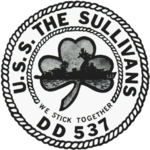 |
| General characteristics | |
| Class and type | Fletcher-class destroyer |
| Displacement | 2,050 long tons (2,080 t) |
| Length | 376 ft 6 in (114.76 m) |
| Beam | 39 ft 8 in (12.09 m) |
| Draft | 17 ft 9 in (5.41 m) |
| Installed power |
|
| Propulsion |
|
| Speed | 35 knots (65 km/h; 40 mph) |
| Range | 6,500 nmi (12,000 km; 7,500 mi) at 15 kilometres (9.3 mi) |
| Complement | 336 |
| Armament |
|
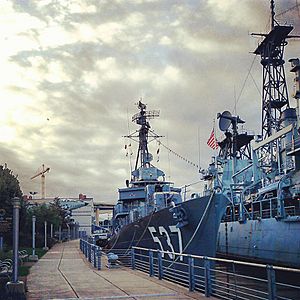 |
|
| Location | Buffalo, New York |
| NRHP reference No. | 86000085 |
| Significant dates | |
| Added to NRHP | 14 January 1986 |
| Designated NHL | 14 January 1986 |
The USS The Sullivans (DD-537) is a famous retired United States Navy warship. It is a type of ship called a Fletcher-class destroyer. This ship was named to honor five brothers from one family, the Sullivan brothers. Their names were George, Francis, Joseph, Madison, and Albert. They were all between 20 and 27 years old. All five brothers died together when their ship, the light cruiser USS Juneau, was sunk by a Japanese submarine. This happened during the Naval Battle of Guadalcanal on November 13, 1942. It was the biggest loss of life for one American family during World War II. The Sullivans was also the first Navy ship ever named after more than one person.
After serving in both World War II and the Korean War, The Sullivans became a training ship. It was officially taken out of service on January 7, 1965. In 1977, the ship was given to the Buffalo and Erie County Naval & Military Park in Buffalo, New York. Today, it is a special memorial museum ship where people can visit and learn about its history. In April 2022, the ship had a serious leak and partly sank, but it has since been repaired and reopened.
Contents
Building the Ship and Its Early Days
The Sullivans was first started on October 10, 1942, in San Francisco. It was built by the Bethlehem Shipbuilding Corporation. The ship was first going to be called Putnam. Then, it was renamed Sullivan. But President Franklin Roosevelt changed the name to The Sullivans. This was to make it clear that the ship honored all five Sullivan brothers. The new name became official on February 6, 1943. The ship was launched on April 4, 1943. Mrs. Thomas F. Sullivan, the mother of the five brothers, was the ship's sponsor. The Sullivans officially joined the Navy on September 30, 1943.
World War II: 1944 Battles
After some test runs, The Sullivans sailed to Pearl Harbor in December 1943. It joined a group of destroyers. In January 1944, the ship headed to the Marshall Islands for battle. It helped protect large aircraft carriers like USS Essex and Intrepid. These carriers launched many air attacks against Japanese targets. The Sullivans stayed near the islands during the Battle of Kwajalein.
In February, The Sullivans helped protect carriers during a big raid on Truk, a Japanese base. During this raid, the carrier Intrepid was hit by a torpedo. The Sullivans stayed with the damaged carrier and helped escort it to safety for repairs.
Later, the ship screened carriers during more air strikes in the Pacific. These strikes targeted places like the Palaus and New Guinea. In April 1944, during an attack on Truk, Japanese planes fought back. The Sullivans used its guns to shoot down one enemy aircraft.
In May, The Sullivans helped bombard the island of Ponape. It fired at Japanese landing barges. The ship then continued to protect carriers during attacks on Marcus and Wake Islands.
In June, the destroyer went to Saipan, Tinian, and Guam. It screened carriers launching air strikes to support American landings. On June 19, during the Battle of the Philippine Sea, Japanese planes attacked. The Sullivans shot down one of these planes. The ship also rescued 31 Japanese sailors after their ship was sunk.
On July 4, The Sullivans joined a group to bombard Iwo Jima. It fired at airfields and shore batteries. The ship destroyed five Japanese planes on the ground. It also helped set an enemy ship on fire.
For the rest of July and August, The Sullivans continued to protect carriers. They launched air strikes on Guam, Rota Island, and the Palaus. In September, the ship supported attacks on Japanese air bases in the Philippines.
In October, The Sullivans was damaged in a storm at Ulithi. It collided with another destroyer. The ship also rescued four men from a sinking boat. After repairs, it joined carriers for raids on Formosa and the Ryukyus. On October 12, Japanese planes attacked the American fleet for hours. The Sullivans fired at five enemy planes.
The next day, Japanese torpedo planes damaged two American cruisers, Canberra and Houston. The Sullivans helped protect these damaged ships. It also rescued 118 men from Houston. For his brave actions, the ship's commander, Ralph J. Baum, received a Silver Star medal.
On October 20, The Sullivans supported the Leyte landings in the Philippines. It shot down a Japanese "Oscar" fighter plane. On October 25, the ship was part of a group that chased Japanese forces. It helped sink an enemy cruiser. The destroyer stayed in the Philippines, protecting carriers and rescuing pilots. In November, its guns shot down another Japanese plane.
In December, The Sullivans screened carriers during air strikes on Manila and Luzon. On December 18, the fleet was hit by Typhoon Cobra. Three destroyers sank, but The Sullivans survived without damage. It then helped search for sailors lost from other ships.
World War II: 1945 Final Battles
In January 1945, The Sullivans screened carriers attacking Formosa to support landings on Luzon. The task force then entered the South China Sea. Carrier planes attacked Japanese ships in Saigon and Camranh Bay. The Sullivans also served on radar picket duty during strikes on Hainan Island, Hong Kong, and Formosa.
After a short break, the ship joined carriers for air strikes on Japan itself. They hit Tokyo and other targets in February. From February 18 to 21, American planes attacked Japanese positions during the Battle of Iwo Jima. On March 1, The Sullivans helped destroy a floating mine. Then, its planes attacked Japanese positions on Okinawa.
On March 20, while refueling, a Japanese kamikaze plane attacked. The Sullivans quickly moved away from the carrier. Another kamikaze crashed into Halsey Powell, a sister ship. The Sullivans went to help Halsey Powell. While doing so, another kamikaze tried to crash into The Sullivans. The destroyer quickly dodged the plane, and its guns fired at it. The plane flew over the ship and escaped. The next day, The Sullivans and Halsey Powell shot down two more Japanese planes.
In April, The Sullivans guarded carriers supporting the invasion of Okinawa. It was on radar picket duty and shot down one enemy plane. On May 11, a kamikaze hit the carrier Bunker Hill. The Sullivans rushed to help. It rescued 166 sailors who had jumped into the water to escape the fires.
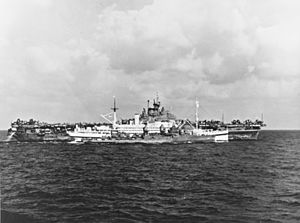
Three days later, another kamikaze hit the carrier Enterprise. The Sullivans shot down one of the attacking planes. This was its last combat action in World War II.
The Sullivans went to Leyte Gulf for rest and repairs. It then sailed back to the United States. The ship arrived at Mare Island Naval Shipyard in California on July 9. It began a major overhaul. Because the war ended, the Navy needed fewer ships. So, The Sullivans was taken out of service on January 10, 1946. It was placed in the Pacific Reserve Fleet.
Korean War Service
The Sullivans stayed out of service until May 1951. It was reactivated because the Korean War caused the Navy to grow. The ship was recommissioned on July 6, 1951. It then sailed to its new home port in Newport, R.I.. During the winter of 1951–52, the ship trained off the east coast and in the Caribbean.
On September 6, 1952, The Sullivans left Newport for Japan. It arrived at Sasebo, Japan on October 10, 1952. The next day, it joined Task Force 77 off Korea. Its job was to protect fast carriers. These carriers launched air strikes to stop enemy supplies. The ship also supported United Nations ground forces fighting communist forces.
After a short break, The Sullivans returned to Task Force 77 in November 1952. It continued to protect carriers. These carriers launched attacks close to the Soviet base at Vladivostok. Enemy MiG-15 fighter jets approached the task force. But American Grumman F9F Panther jets shot down two of them. This was the first time jet fighters fought over water.
In December 1952, The Sullivans joined United Nations forces. It helped blockade the Korean coasts. Its mission was to stop enemy ships and bombard targets on shore. On December 16, it found the enemy off Songjin, North Korea. This was an important rail and supply center. For several days, the ship fired at railroad trains and tunnels. It destroyed railroad cars and buildings.
On Christmas Day 1952, The Sullivans hit a railroad bridge. Enemy artillery on shore fired back. Fifty rounds missed the ship, but shell fragments landed on its decks. The ship fired back and destroyed at least one enemy artillery position.
The Sullivans left Japan on January 26, 1953, to return home. It visited many ports around the world, including Hong Kong, Singapore, and Bombay. It sailed through the Red Sea and the Suez Canal. After stopping in France and Gibraltar, the warship reached Newport, R.I., on April 11, 1953.
Serving with the 6th Fleet
The destroyer operated from Newport until the summer of 1953. Then, it went to the Mediterranean Sea to serve with the 6th Fleet. It returned to Newport in February 1954. For the next year, it operated off the east coast and in the Caribbean. It deployed to Europe and the Mediterranean again from May to August 1955.
In the following years, The Sullivans continued to switch between operations on the east coast and deployments to the Mediterranean. In 1958, there was a threat in Lebanon. President Dwight D. Eisenhower sent American ships to land troops there. This was to protect Americans and help stabilize the situation. The Sullivans supported the landing of Marines in Beirut. After the crisis ended, the ship returned to the United States for repairs and training.
In March 1959, The Sullivans joined a group that hunted submarines. It also took students from the USNA and NROTC on training cruises. Then, it sailed for another Mediterranean deployment.
In March 1960, the warship helped rescue five survivors from a U.S. Air Force KC-97 Stratofreighter plane. The plane had crashed off the coast of Florida. Later that year, The Sullivans took part in joint exercises with Pakistani, Iranian, and British warships. It also trained with the French Navy.
In January 1961, The Sullivans helped test the nuclear submarine Abraham Lincoln. It then took part in training exercises in the Caribbean. In April, the ship prepared to support a Project Mercury space mission. On May 5, 1961, Commander Alan Shepard's space capsule, Freedom 7, splashed down near the carrier Lake Champlain. Helicopters quickly rescued him. The Sullivans then took students on another training cruise.
From September 1961 to February 1962, The Sullivans had a major overhaul. It then trained at Guantanamo Bay Naval Base to become a school ship. It was used to teach officer students how to operate a destroyer.
In October 1962, Soviet missiles were found in Cuba. The Sullivans joined American naval forces that blockaded the island. After the Soviet Union removed the weapons, the destroyer returned to Newport.
In 1963 and 1964, The Sullivans continued to train officer students. On April 1, 1964, the ship was moved to the Naval Reserve Force. Its homeport changed to New York City. It took on a crew of reserve sailors. Its cruises with the reserves focused on anti-submarine warfare exercises. It visited Canadian ports and Palm Beach, Florida.
A Museum Ship
The Sullivans earned nine battle stars for its service in World War II. It earned two more for its service in the Korean War. On January 7, 1965, The Sullivans was officially taken out of service. It remained in reserve until the 1970s. In 1977, it was donated to the Buffalo and Erie County Naval & Military Park in Buffalo, New York. Today, the ship is a memorial and is open for public tours.
The ship was named a National Historic Landmark in 1986. In February 2021, it was reported that The Sullivans was taking on water and leaning. This was likely due to its age and weather damage.
On April 14, 2022, the ship began to lean more and sit lower in the water. Crews said the ship had lost electrical power. A public statement later reported a "serious hull breach." Part of the ship was resting on the riverbed, but most of it was still above water. An inspection in May showed a lot of damage inside the ship.
In August 2022, The Sullivans reopened for visitors after repairs. In summer 2023, the park started work to prepare the ship for winter. This included adding new sensors to warn of leaks and replacing mooring lines. The park plans to move the ship to a drydock by late 2024 for more repairs. This will require a lot of money for towing and repairs. As of August 2025, the ship's lower decks are closed to visitors. Only the main deck and part of the top structure are open.
Awards
The Sullivans earned nine battle stars in World War II. It earned two more during the Korean War.
Other Ships Like The Sullivans
Three other ships of the same class as The Sullivans (Fletcher-class destroyers) are also preserved as memorials:
- USS Cassin Young (DD-793) in Boston, Massachusetts
- USS Kidd (DD-661) in Baton Rouge, Louisiana
- Greek destroyer Velos (formerly USS Charrette) in Thessaloniki, Greece


